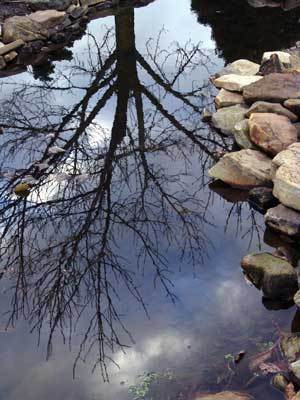 As the air temperature cools, so does the temperature of the water in your pond. When average daily temperatures drop below 60-70º F, significant biological changes start to take place in aquatic plants and fish. Here are some tips for preparing your pond for winter.
As the air temperature cools, so does the temperature of the water in your pond. When average daily temperatures drop below 60-70º F, significant biological changes start to take place in aquatic plants and fish. Here are some tips for preparing your pond for winter.
Immerse tender plants in a tub or container filled with water so that they are 1-2 inches below the surface. Store them in a cold room like an unheated basement. An alternative method is to bury the rhizomes. Wash them thoroughly, removing any old stems and roots, and bury them in a bucket filled with clean, damp sand or damp sphagnum moss. Check the plants frequently to make sure the roots don't dry out.
If you have a small pond, it may be easiest just to set up winter housing for your plants and fish and take your pond completely apart-storing all of the components over winter. This is probably a necessity in harsher climates where shallow pond may freeze solid. Start by setting up winter housing for your fish and aquatic plants. This means bringing tender plants indoors and getting an indoor tank set up and running several weeks in advance of transferring your fish.
Perform Maintenance & Testing: The first step to preparing your large pond for winter is to clean out the bottom and test the water. Remove as much plant debris from the bottom of the pond as possible by skimming, vacuuming and netting and make sure the skimmers, filters and pump are clean and in good working order. Lastly, test the bio-load and oxygen levels of the water.
Change & Reduce Fish Food: As the temperatures drop below 70º F, reduce the amount of food you feed your fish as well as gradually switching them to a lower protein feed so that by the time temperatures drop below 60ºF, they are being fed a wheat-germ based food exclusively. At temperatures below 50ºF, the bacteria in their digestive tract can no longer effectively process food. At this point, some experts state that feeding should be stopped entirely until temperatures climb back above 50º F.
Provide Fish Cover: Fish feel safe from predators under the cover of aquatic plants. Removing your plants for the winter may leave fish feeling vulnerable and place them under additional stress. Use PVC or plastic trash cans to provide them with places to take cover during the winter.
Remove Mechanicals: If you keep fish, once the temperature drops below 40º F, remove and clean the pump and filters and store them for winter. In a correctly designed pond, warm water settles to the bottom. Because pumps pull water from the bottom and move it toward the surface, its better to leave the warm water on the bottom undisturbed in the winter rather than circulating it to the top with a pump and exposing it to freezing temperatures. A pump left running over winter can actually lower the water temperature too much for your fish to survive.
Preventing An Ice Over: Use a floating pond heater or de-icing unit to keep your pond from completely freezing over. It's important to keep at least a small portion of the pond open in order to facilitate the release of toxic gases and allow oxygen into the pond. To sustain water temperatures artificially over winter (e.g. 50-65º F) can be a breeding ground for bacteria and can do your fish more harm than good. Heaters should not heat the pond, but merely keep it from icing over. NEVER use a hammer to crack or break the ice. You may injure your fish.
Apply Protective Netting: Falling leaves and winter winds can fill your pond with debris. Not only does this build up on the bottom of your pond, but the decaying vegetation increases the amount of dissolved oxygen in the water which stresses out the fish and plants who are already dealing with cooler temperatures. Help prevent this by covering you pond with a mesh net and anchoring it to the sides. As debris falls, simply take up one side of the net, shake off the debris and reattach the netting. This will keep the majority of the leaves and debris out of your pond and save your time cleaning up in the spring.
This page contains the following solutions.
If you are trying to keep ornamental fish outdoors during the winter but find that they don't seem to be surviving the season the culprit is your pond liner. It is simply not deep enough to allow the Koi fish to find a place to hibernate for the winter.
This is a page about preparing your yard for winter. Protecting anything that may be damaged by cold and moisture will assure that you can use these things next summer.